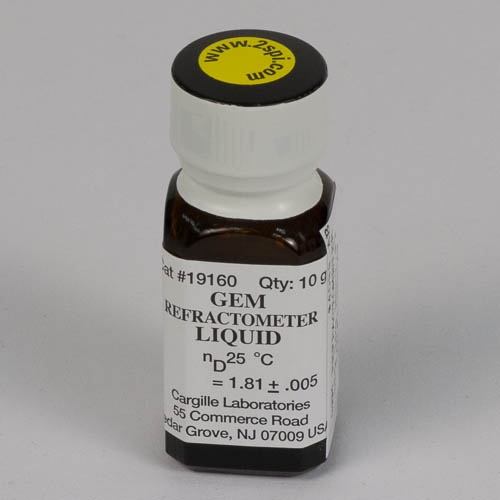Cargille Gem Refractometer Liquid 10g
The Cargille Gem Refractometer Liquid has a refractive index of nD = 1.810, the highest of any liquid not containing arsenic. It is widely used with gem refractometers as a contact medium for the identification of gemstones. This light yellow liquid can also be used to reduce or eliminate glare from a gem's surface, facilitating inspection of the gem's interior for inclusions and other defects.
Remember that we offer a complete range of refractive index matching fluids.
This liquid is supplied in an amber glass bottle. The cap has a glass applicator rod attached to it on the inside, designed to deliver a small droplet.
To ensure the liquids maximum shelf life, keep this liquid tightly sealed after opening, store it away from direct light and in moderate temperatures.
Specifications:
nD = 1.81 +/- 0.005 @ 25°C
| Composition | Methylene Iodide with dissolved solids |
| Appearance | Golden yellow liquid |
| Odor | Characteristic |
| Color Stability | In sun: Will become very dark after I day (Note: When stored in the dark the color is stabilized for up 5 years by the small piece of copper normally placed in the bottle by Cargille Labs) |
| Index Change Rate by Evaporation | High: A 1/4 fl. oz. bottle open 5 days: full bottle changed +0.00130; half full (10 gram) changed +0.00207 |
| Pour Point °C | < 20 |
| Boiling Point °C @ 760mm Hg | > 180 |
| Flash Point °C COC | None |
| Density g/cc @ 25 °C | 3.135 |
| Density Temp. Coef. g/cc °C | -0.0023 |
| Coef. of Therm. Exp. cc/cc/ °C | 0.0007 |
| Viscosity centistokes @ 25 °C | 2 |
| Soluble: No common solvents | |
| Partly Soluble: Acetone, Carbon Tetrachloride, Ethyl Ether, Methylene, Chloride, Toluene, Xylene | |
| Insoluble, Ethanol, Freon TF, Heptane, Naphtha, Turpentine, Water | |
| Clean Up: Wipe until dry with tissue, then use soap and water if further cleaning needed. Avoid letting liquid evaporate leaving crystals behind. To help remove crystals: Soak in soap and water or Carbon Tetrachloride or use of scouring pad when not injurious to item cleaned. | |
| Compatibility: May soften some plastics (Especially Polystyrene, Polyethylene, and Polyurethane) and may affect epoxy, rubber (including Silicone and Neoprene), and will corrode Aluminum, Brass, Copper, and Steel | |
| Toxicity Moderate (request MSDS) | |
| Cauchy Equation: Refractive index as a function of wavelength at 25 °C | |
|
|
| Source or | Wavelength | Refractive Index | % Transmittance 25 °C | ||
| Spectral Line | (angstroms) | 25 °C | 1 mm | 1cm | 10cm |
| Near UV cut off | 4500 | 1.86 | 5 | 0 | 0 |
| F (Cd) | 4800 | 1.846 | 88 | 28 | 0 |
| F (H) | 4861 | 1.843 | 89 | 32 | 0 |
| Ar laser | 4880 | 1.842 | 90 | 35 | 0 |
| e (Hg) | 5461 | 1.821 | 95 | 62 | 1 |
| d (He) | 5876 | 1.810 | 98 | 82 | 13 |
| D (Na) D1, D2 mean | 5893 | 1.810 | 98 | 82 | 14 |
| He laser | 6328 | 1.802 | 99 | 90 | 35 |
| C (Cd) | 6439 | 1.800 | 99 | 91 | 40 |
| C (He) | 6563 | 1.798 | 99 | 92 | 43 |
| Ruby laser | 6943 | 1.793 | 99 | 94 | 55 |
| GaAs laser | 8400 | 1.780 | 100 | 99 | 90 |
| Nd: YAG laser | 10648 | 1.77 | 100 | 97 | 74 |
| Diode | 13000 | 1.77 | 100 | 100 | 96 |
| Diode | 15500 | 1.76 | 99 | 93 | 49 |
| nF - nC | = 0.0448 | ||||
| Abbe vD: (nD - 1) / (nF - nC) | = 78.1 | ||||
| Temp. coef dnD / dt 20 - 25 °C | = -0.000680 | ||||

